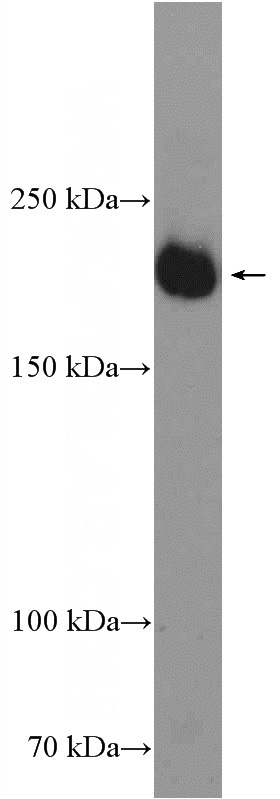-
Product Name
VEGF Receptor 2 antibody
- Documents
-
Description
VEGF Receptor 2 Rabbit Polyclonal antibody. Positive WB detected in human placenta tissue, mouse heart tissue. Positive IHC detected in human oesophagus cancer tissue, human colon cancer tissue, human lung cancer tissue. Observed molecular weight by Western-blot: 200 kDa
-
Tested applications
ELISA, IHC, WB
-
Species reactivity
Human, Mouse; other species not tested.
-
Alternative names
CD309 antibody; Fetal liver kinase 1 antibody; FLK 1 antibody; FLK1 antibody; KDR antibody; Kinase insert domain receptor antibody; VEGF Receptor 2 antibody; VEGFR antibody; VEGFR 2 antibody; VEGFR2 antibody
-
Isotype
Rabbit IgG
-
Preparation
This antibody was obtained by immunization of VEGF Receptor 2 recombinant protein (Accession Number: NM_002253). Purification method: Antigen affinity purified.
-
Clonality
Polyclonal
-
Formulation
PBS with 0.1% sodium azide and 50% glycerol pH 7.3.
-
Storage instructions
Store at -20℃. DO NOT ALIQUOT
-
Applications
Recommended Dilution:
WB: 1:200-1:2000
IHC: 1:50-1:500
-
Validations

human placenta tissue were subjected to SDS PAGE followed by western blot with Catalog No:116736(KDR Antibody) at dilution of 1:600

Immunohistochemistry of paraffin-embedded human oesophagus cancer tissue slide using Catalog No:116736(KDR Antibody) at dilution of 1:200 (under 10x lens).

Immunohistochemistry of paraffin-embedded human oesophagus cancer tissue slide using Catalog No:116736(KDR Antibody) at dilution of 1:200 (under 40x lens).
-
Background
KDR, also named as VEGFR-2, FLK1 and CD309, is a receptor for VEGF or VEGFC. KDR which belongs to the protein kinase superfamily, has a tyrosine-protein kinase activity. The VEGF-kinase ligand/receptor signaling system plays a key role in vascular development and regulation of vascular permeability. In case of HIV-1 infection, the interaction with extracellular viral Tat protein seems to enhance angiogenesis in Kaposi's sarcoma lesions. KDR functions as the main mediator of VEGF-induced endothelial proliferation, survival, migration, tubular morphogenesis and sprouting. Mutations of this gene are implicated in infantile capillary hemangiomas.
Related Products / Services
Please note: All products are "FOR RESEARCH USE ONLY AND ARE NOT INTENDED FOR DIAGNOSTIC OR THERAPEUTIC USE"
